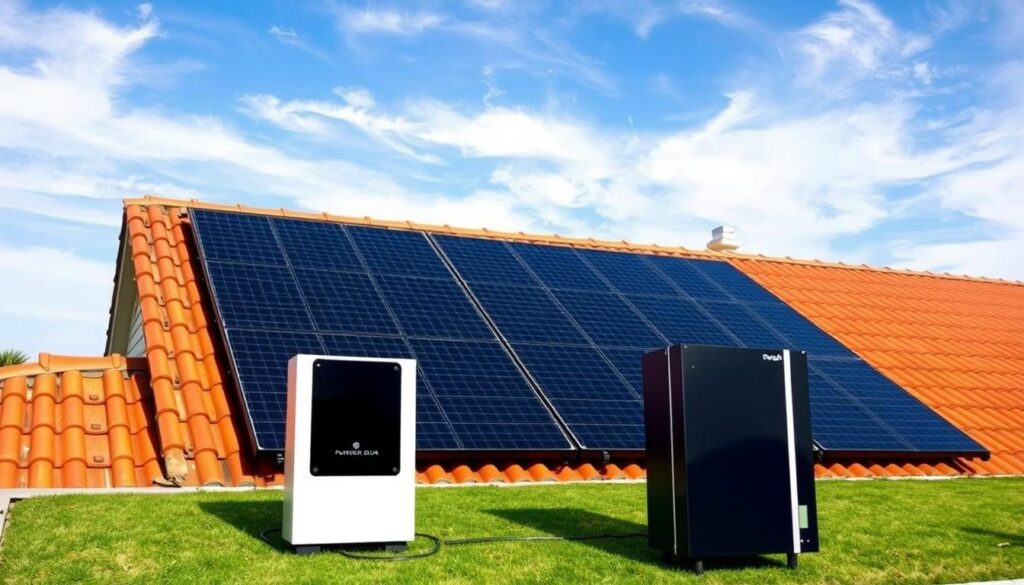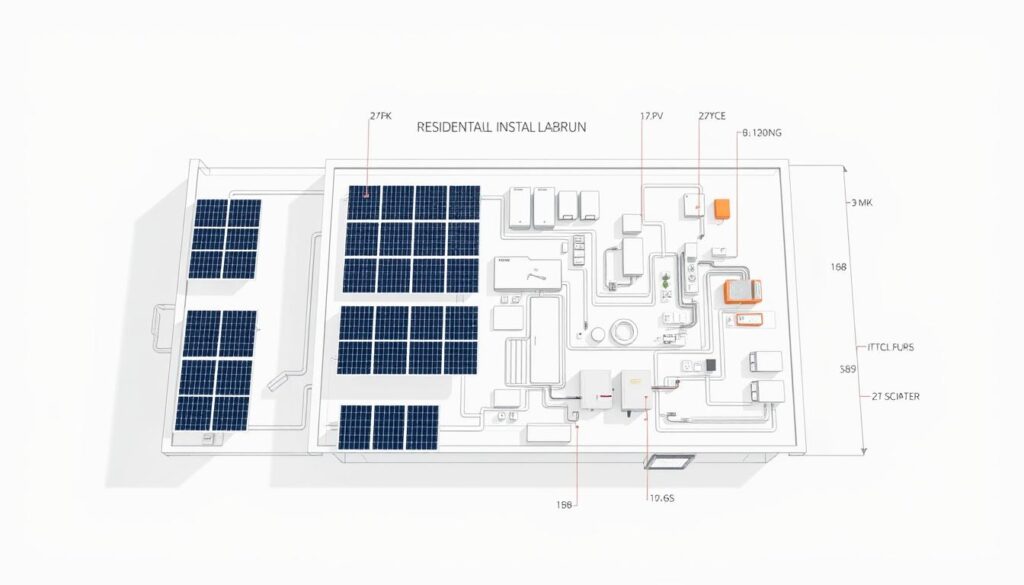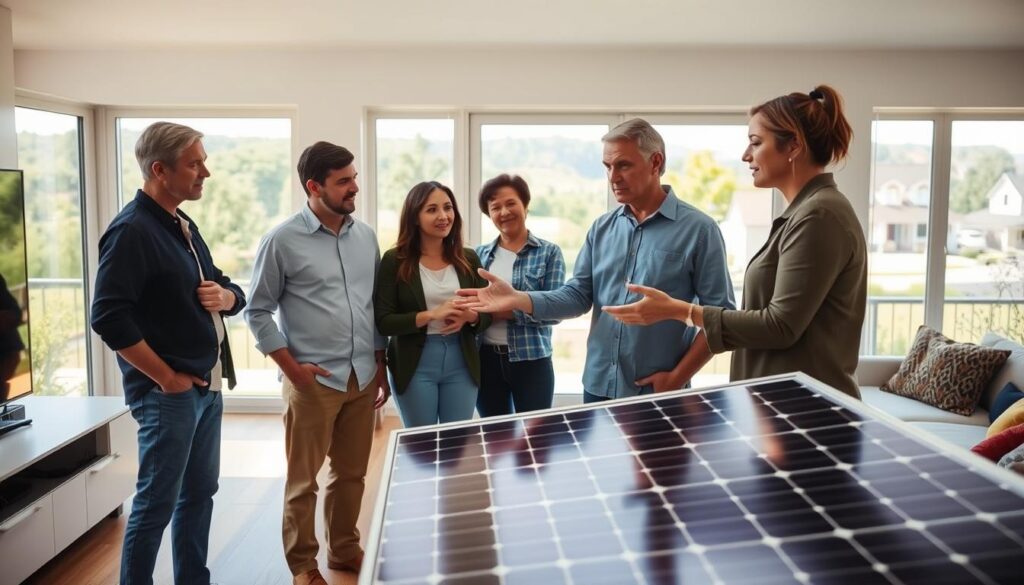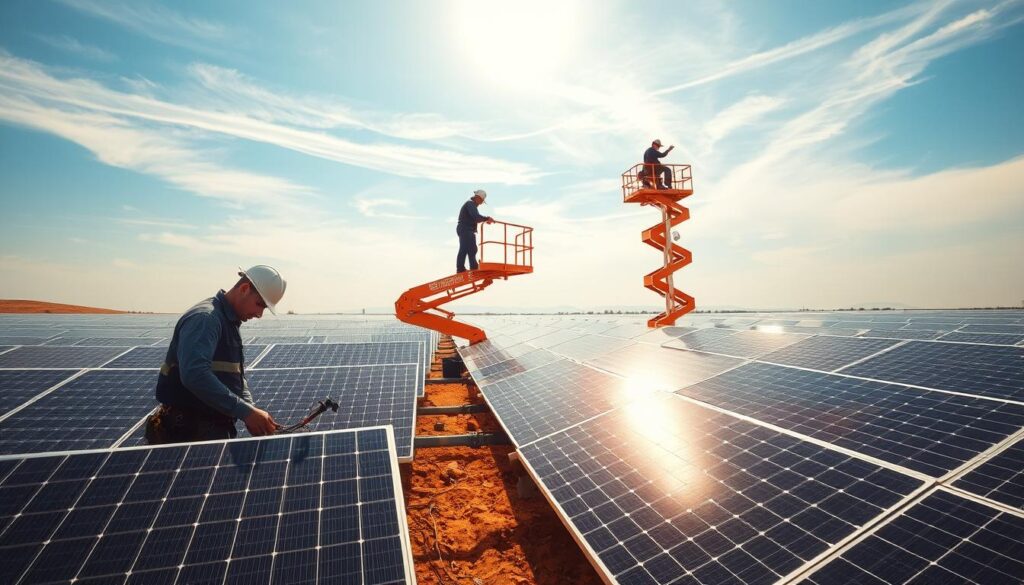Switching to a solar energy system is one of the smartest decisions you can make for your household. With advancements in technology, modern solar panels are more efficient and affordable than ever. According to the U.S. Department of Energy, hundreds of thousands of installations across the country have made this renewable option accessible to more Americans.
By adopting solar solutions, you can significantly reduce your electricity bills while shrinking your carbon footprint. These systems convert sunlight into usable power, ensuring your home stays energized even during peak hours. Plus, federal incentives and tax credits make the transition easier on your wallet.
This guide will walk you through everything you need to know about harnessing the sun’s power. From understanding how solar panels work to exploring financial benefits, we’ll help you take the first step toward energy independence.
Key Takeaways
- Solar energy systems reduce electricity bills and carbon footprints.
- Modern solar panels are highly efficient and affordable.
- Federal incentives make solar installations more accessible.
- Solar technology converts sunlight into usable power for your home.
- Adopting solar solutions increases energy independence.
Introduction: Harnessing the Sun for Your Home
More homeowners are turning to renewable solutions to power their lives. With rising electricity costs and growing environmental concerns, modern technologies are becoming a top choice. According to the Solar Energy Technologies Office, installations have surged, making these systems more accessible than ever.
Why Renewable Power is Gaining Popularity
The appeal of clean energy lies in its dual benefits: saving money and protecting the planet. Advanced technology has made these systems more efficient and affordable. Better financing options, like leases and loans, are also encouraging adoption.
Residential properties with these installations enjoy lower utility bills and increased value. Studies show homes with such systems sell for 4.1% more. Additionally, federal incentives and tax credits make the transition easier on your wallet.
Here are the key reasons behind the growing interest:
- Cost Savings: Reduce electricity bills by up to 70%.
- Property Value: Increase home value by $20 for every dollar saved.
- Environmental Impact: Cut carbon emissions by 3-4 tons annually.
- Accessibility: Installation costs have dropped by over 50% in the last decade.
| Feature | Traditional Power | Renewable Power |
|---|---|---|
| Cost per kWh | 7.8 cents | 4.3 cents |
| Environmental Impact | High emissions | Low emissions |
| Long-Term Savings | Minimal | Over $20,000 |
| Property Value Increase | None | 4.1% |
With these advantages, it’s no wonder more Americans are embracing this technology. Whether it’s for financial savings or environmental responsibility, the benefits are clear.
Understanding home solar energy Basics
The science behind generating power from sunlight is both fascinating and practical. Modern technology has made it easier than ever to harness this renewable resource. By understanding the basics, you can make informed decisions about adopting this innovative solution.

How Panels Convert Sunlight to Electricity
Panels use the photovoltaic effect to turn sunlight into direct current (DC) electricity. This process involves photons from sunlight knocking electrons loose in the panel’s cells, creating an electric flow. The result is clean, renewable electricity ready for use.
An inverter then transforms DC into alternating current (AC), which powers your appliances. This step is crucial because most household devices run on AC. Together, these components ensure a seamless transition from sunlight to usable power.
Essential Components of a Solar Setup
A typical system includes several key parts. Panels capture sunlight, while racking secures them in place. Wiring connects the panels to the inverter, which converts the electricity. Each component plays a vital role in the system’s efficiency.
The cost per watt of installation impacts overall affordability. Advances in technology have driven prices down, making this option more accessible. Additionally, financing plans and incentives can further reduce upfront expenses.
Depending on your needs, there are various installation options to consider. Whether you choose a grid-tied or off-grid system, each has unique benefits. Consulting with a professional can help you select the best setup for your situation.
Assessing Your Home’s Solar Potential
Determining your property’s suitability for renewable systems starts with a thorough evaluation. Factors like roof orientation, shading, and structural integrity play a crucial role in maximizing efficiency. By understanding these elements, you can make informed decisions and ensure optimal performance.
Evaluating Roof Orientation and Shade
The direction your roof faces significantly impacts energy production. South-facing roofs receive the most sunlight, making them ideal for installations. East and west-facing options can still work but may yield slightly lower output. North-facing roofs are generally less suitable due to limited direct sunlight.
Shading from trees, chimneys, or nearby buildings can also affect performance. Even minor shade can reduce efficiency, so it’s essential to assess your property for potential obstructions. Tools like the PVWatts Calculator can help estimate how shading impacts your system’s output.
Utilizing Mapping Tools for Accurate Estimates
Advanced mapping tools provide precise estimates of your property’s potential. The National Renewable Energy Laboratory’s PVWatts tool, for example, calculates energy production based on location, roof orientation, and shading. These insights help homeowners understand expected savings and system size.
Additionally, analyzing your current utility bill can provide valuable context. By comparing usage patterns, you can estimate potential savings post-installation. This step ensures your system is tailored to meet your specific needs.
| Factor | Impact on Solar Potential |
|---|---|
| Roof Orientation | South-facing roofs maximize sunlight exposure. |
| Shading | Even minor shade can reduce efficiency by up to 20%. |
| Roof Condition | Structurally sound roofs ensure long-term durability. |
| Mapping Tools | Accurate estimates help optimize system size and savings. |
Working with experienced installers is another critical step. They can assess your property’s suitability, recommend the best setup, and ensure compliance with local regulations. By taking these steps, you can confidently move forward with your renewable journey.
Planning Your Solar Installation Journey
Starting your journey toward renewable power begins with careful planning. A successful residential solar setup involves several critical steps, from assessing your property to navigating local regulations. By taking the time to prepare, you can ensure a smooth and efficient process.

Initial Steps and Home Energy Audits
Before diving into the installation, conduct a comprehensive home energy audit. This assessment identifies areas where you can improve efficiency and reduce overall consumption. By addressing these issues early, you can maximize the benefit of your new system.
Energy audits often reveal simple fixes, like upgrading insulation or sealing leaks. These improvements not only lower your energy usage but also make your residential solar setup more effective. Many utility companies offer free or discounted audits, making this step accessible and cost-effective.
Navigating Local Permitting and Regulations
Securing the necessary permits is a crucial part of the process. Each state and municipality has specific requirements, so it’s essential to research local regulations. Working with experienced installers can simplify this step, as they often handle the paperwork on your behalf.
Early planning also allows you to tap into accurate sources of information and leverage available incentives. Programs like the federal tax credit can significantly reduce upfront costs. By preparing detailed documentation and cost analysis, you can ensure a smoother installation journey.
Exploring Solar Equipment and Technology
Modern advancements in renewable technology have made it easier than ever to harness the sun’s power efficiently. Whether you’re considering installing a system or upgrading an existing one, understanding the equipment and system types is crucial. This section dives into the key components and configurations that maximize the value of your investment.
Overview of Solar Panels, Inverters, and Batteries
At the heart of any system are the panels, which capture sunlight and convert it into electricity. Modern panels are highly efficient, with monocrystalline options offering the best performance. Inverters play a critical role by transforming the direct current (DC) produced by panels into alternating current (AC) for household use.
Batteries add another layer of advantage by storing excess energy for later use. Lithium-ion batteries, for example, are a popular choice due to their longevity and reliability. Together, these components ensure a seamless and efficient energy solution.
System Types: Grid-Tied, Hybrid, and Off-Grid Options
Choosing the right system type depends on your needs and location. Grid-tied systems are the most common, allowing you to feed excess energy back into the grid for credits. Hybrid systems combine grid-tied functionality with battery storage, offering greater flexibility.
Off-grid systems are ideal for remote locations, providing complete energy independence. Each option has its own value and advantage, making it essential to evaluate your specific requirements before deciding.
| System Type | Key Features | Best For |
|---|---|---|
| Grid-Tied | Connects to the utility grid, allows net metering | Urban and suburban areas |
| Hybrid | Combines grid connection with battery storage | Areas with frequent power outages |
| Off-Grid | Fully independent, no grid connection | Remote or rural locations |
Investing in high-quality equipment and the right system type can save you money in the long run. Modern technology has significantly reduced installation costs while improving performance. By making informed choices, you can maximize the value of your renewable energy system.
Financing Solar Projects and Maximizing Savings
Investing in renewable power systems can lead to significant financial and environmental benefits. With various financing options and incentives available, understanding how to maximize your savings is crucial. This section breaks down the key aspects of financing, including incentives, rebates, and calculating your return on investment.
Understanding Incentives, Rebates, and Tax Credits
One of the most attractive aspects of renewable power is the availability of financial incentives. The federal Investment Tax Credit (ITC) offers a 30% credit on the total system cost for installations completed between 2022 and 2032. This credit applies not only to panels but also to components and labor costs.
Many states also offer additional rebates and incentives. For example, New York and Maryland have programs that further reduce upfront costs. These incentives can significantly lower the initial amount you need to invest, making renewable power more accessible.
Calculating Costs and Return on Investment
Understanding the costs and potential savings is essential for making an informed decision. The average cost of a residential system ranges from $2.50 to $4.50 per watt, with a typical 11 kW system costing around $22,022 before incentives. After applying the ITC, the net cost drops to approximately $15,415.
To calculate your return on investment, consider your current electricity bills and the expected lifespan of the system, which is typically 25 years or more. For example, if you pay $150 per month for electricity, you’ll spend over $65,000 in 25 years. By switching to renewable power, you can eliminate or drastically reduce this expense.
| Financing Option | Key Features | Best For |
|---|---|---|
| Cash Purchase | Full ownership, eligible for tax credits | Those with upfront capital |
| Solar Loans | Ownership, tax credits, fixed payments | Homeowners seeking long-term savings |
| Solar Leases | No upfront cost, fixed monthly payments | Those avoiding upfront expenses |
| Power Purchase Agreements (PPAs) | Pay for electricity produced, no ownership | Homeowners with limited capital |
Programs like Solarize and community initiatives can also reduce costs by leveraging group purchasing power. These programs often provide additional savings and make renewable power more affordable for everyone.
By carefully evaluating your options and taking advantage of available incentives, you can maximize your savings and enjoy the long-term benefits of renewable power. Whether you choose to buy, lease, or finance, the financial and environmental rewards are clear.
Selecting a Trusted Solar Installer
Choosing the right installer is a critical step in ensuring a smooth and efficient installation process. A qualified professional not only guarantees safety and compliance but also maximizes the benefit solar systems offer. With so many options available, it’s essential to vet installers carefully to avoid costly mistakes.

Key Certification and Licensing Criteria
Reputable installers should hold certifications like the North American Board of Certified Energy Practitioners (NABCEP). This credential indicates advanced training and adherence to industry standards. Additionally, verify that the installer has the necessary state and local licenses, such as a C-10 Electrical or B license in California.
Experience matters too. Look for installers with at least three years in the industry and a proven track record. Ask how many systems they’ve installed to gauge their expertise. A clean legal record and OSHA compliance are also signs of a trustworthy contractor.
Comparing Quotes and Customer Reviews
Getting multiple quotes is a smart way to ensure you’re getting the best purchase value. Use tools like the Lawrence Berkeley National Laboratory’s Tracking the Sun report to compare prices. Be wary of quotes that seem too good to be true, as they may indicate subpar equipment or workmanship.
Customer reviews are another valuable resource. Platforms like Google and the Better Business Bureau (BBB) provide insights into an installer’s reputation. Look for consistent positive feedback and quick resolution of any complaints. Personal recommendations from friends or neighbors can also be helpful.
| Criteria | What to Look For |
|---|---|
| Certifications | NABCEP, manufacturer-specific training |
| Licensing | State and local licenses, clean legal record |
| Experience | Minimum three years, proven track record |
| Reviews | Positive feedback, high BBB rating |
A reliable installer will handle everything from permit acquisition to grid connection, saving you time and stress. They’ll also provide a clear timeline for the installation process, ensuring your project stays on track. By taking these steps, you can confidently move forward with your renewable journey.
Optimizing Solar System Maintenance and Longevity
Keeping your system in top shape ensures long-term efficiency and savings. Regular maintenance not only boosts performance but also protects your investment. By following a few simple steps, you can extend the lifespan of your equipment and avoid costly repairs.

Routine Maintenance and Performance Tips
Regular checks are essential for any successful project. Inspect panels for dirt, debris, or damage at least twice a year. Cleaning them with water and a soft brush can improve efficiency by up to 15%. Monitoring systems also play a key role in identifying issues early.
Modern technology makes tracking performance easier than ever. Use apps or software to monitor energy output and detect anomalies. If you notice a drop in efficiency, contact a professional for a thorough inspection. Preventive measures can save you time and money in the long run.
Maximizing Equipment Warranties and Lifespan
Understanding your warranty agreement is crucial. Most warranties cover defects for 25 years but require regular maintenance to remain valid. Keep detailed records of inspections and repairs to ensure compliance. This can prevent disputes and protect your investment.
Tailored plans ensure your property’s needs are met. Work with professionals to create a maintenance schedule that fits your system. They can also help you navigate warranty terms and conditions. By staying proactive, you can maximize the lifespan of your equipment and enjoy consistent performance.
- Schedule inspections at least twice a year.
- Use monitoring tools to track system performance.
- Keep detailed records of maintenance and repairs.
- Consult professionals for tailored maintenance plans.
Conclusion
Embracing renewable solutions offers both financial and environmental rewards. By adopting this type of technology, you can reduce your carbon footprint while enjoying significant savings on utility bills. Proper planning, quality installations, and regular maintenance are key to maximizing the benefits of your system.
The industry continues to evolve, making these systems more efficient and affordable. With the federal tax credit still available, now is an excellent time to invest. This incentive can cover up to 30% of your installation costs, making the transition even more accessible.
Assessing your property’s potential is the first step toward a successful project. Trusted professionals can guide you through the process, ensuring your system is tailored to your needs. Start your journey today and experience the long-term advantages of solar power.
